The Big Board: ‘Subject to sudden and catastrophic change’
Widji’s high adrenaline rush of organizing a summer of wilderness trips
As featured in Letters from Camp Magazine – Spring 2025.

Due to unforeseen circumstances, a group of campers was not going to make it to the takeout point by their scheduled pick-up time. A satellite phone call for help to YMCA Camp Widjiwagan’s office kicked off a flurry of activity.
It was time to evacuate a group.
Kurt Simer was Widji’s wilderness program director at the time and Amy Hadow was on trail staff. They recall huddling in the office and studying a map, searching for a road where they could pick up the group, and working to direct the counselors to that location.
“In that part of Canada, it’s possible [we were looking at] an old logging road, so we weren’t 100 percent sure if it would be passable or even there anymore,” Simer said. Because of that, in addition to the van and canoe trailer, at that time, they also packed bikes and a hand saw. “If we found the road wasn’t drivable, the staff could bushwack and bike in to reach the group.”
“All we could think about were the million details we needed to solve to help that group,” Hadow added.
This particular story is from summer 2012 and serves as just one example of the types of challenges that happen every summer, multiple times. Often, though the care and safety of people are always at the center of camp’s priorities, these sorts of problems come down to a Tetris-like game
of logistics.
In 2024, Camp Widjiwagan had:
- 719 campers,
- 84 trail staff, and
- 207 trips.
Which required:
- 112 Boundary Waters Canoe Area Wilderness permits,
- 13 vans driving over 50,000 miles,
- 68 airplane tickets, 12 charter flights and six food/equipment resupply flights.
And those lists don’t even include the thousands of pounds of food, gear, replacement gear, satellite phones, gas, and so much more. Groups are on trips in remote areas and while camp maintains an impressive amount of information about the area the group is traveling, there are always unpredictable aspects that can pose challenges. And when one thing has to change, it has a ripple effect on many other things.
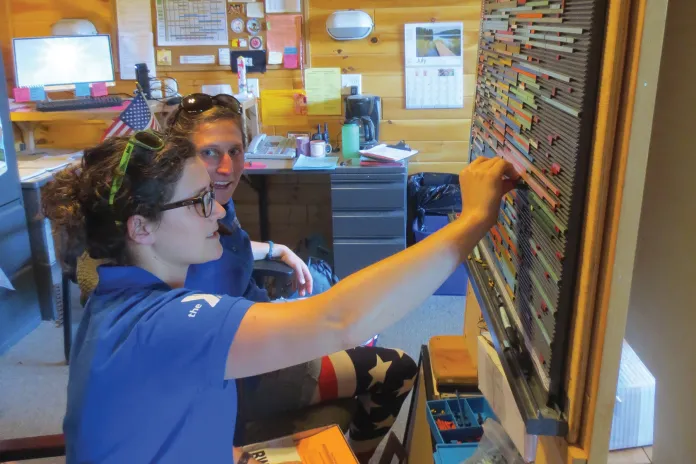
Organizing Widji’s summer: The Big Board
So how do these complex logistics come together, you ask?
In the early 1990s, Rolf Thompson, executive director from 1990-99 introduced the Big Board. After working at YMCA Camp Menogyn where Skip Wilke had created such a board, Thompson knew it was a necessity for Widji too. For the next 30 years, camp’s program directors would come together in marathon scheduling sessions during staff training. After observing staff during training, and factoring in age, experience, availability, gender, and countless other details, the leadership team would spend hours assigning staff to each trip. That schedule, as well as driving assignments, would be arranged on a large, black board with hundreds of tiny rectangular magnetic labels — together making the Big Board.
Prior to the introduction of the Big Board, scheduling was done in a similar way, but on a smaller scale. Over the years, scheduling grew more complex as the number of trips increased, and the Big Board presented a completely unique-to-Widji way of organizing each summer.
The Board became so popular, in fact, it became a routine stop for tours of camp; although to protect it, the staff kept it locked up at night.
It also took on layers of meaning, becoming a visual representation of Widji’s mission. Its annual unveiling during staff training has also become a momentous occasion.
Simer, who served as wilderness program director from 2011-15 and today is a fundraiser on the Y’s Mission Advancement team, said that he and Brian Geisler (program director 2012-16) would “spend a whole morning locked away, assigning trips.” The Big Board was “under serious, CIA-level protection so that no one could see it before it was unveiled.” When it was ready, they would make an announcement at breakfast that “the Big Board is out” and then listen to everyone react to the trips they got assigned.
Across the top of the Big Board is a note that reads, “Subject to sudden and catastrophic change,” which, according to Hadow, who went on to become the summer program director from 2015-23, “has always been the unofficial Widji motto for me.”
Now, Hadow once again works with Simer as a current member of the Y’s Mission Advancement team. (Editor’s note: We like these Widjiwaganites!)
“Brian would take a photo of the Big Board every morning. The board was magnetic, so if it got knocked over, everything would fall off. Without a photo, that was it,” Simer said. “We would have to re-assign all of the trips.”
The pictures were crucial because, as Hadow shared, “I saw that board fall more than once.”
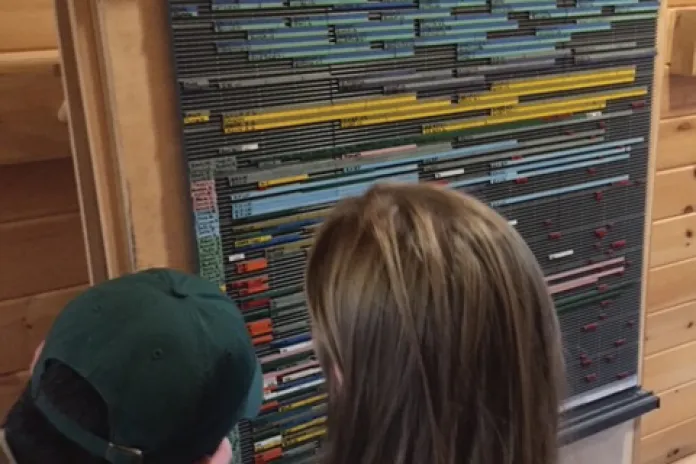
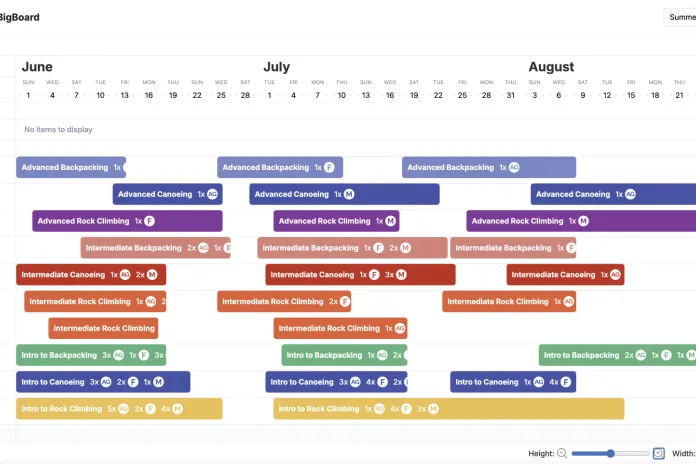
Progress: From magnets to laptops
The Big Board may have been the command center for three decades, but that was before August Halverson. Halverson was a camper from 2013-18, a BOLD and GOLD intern in 2019, and a counselor from 2021- 24. In 2021, then-Executive Director Matt Poppleton found out that Halverson was studying computer science. He made a request to August: Bring Widji into the 21st century.
As Halverson recalled with a smile, “I was surprised Matt asked me because I was still young. I was not that qualified but knew enough to be dangerous. I was excited about the project right away.”
When he returned to college in the fall of 2021, he began working on an electronic version of the Big Board. “Written from the ground up, there was no template or other system to base it off.”
By the following year, summer 2022, the program staff was using his program, dubbed Endeavor Big Board, in place of the original magnetic Big Board. And over the past three years, and after countless hours of work, Halverson has continued to update and improve the program, creating new functions and giving the program directors the ability to run different reports.
In 2024, YMCA Camp Menogyn also started using this program for scheduling.
Camp leadership enters all of the trips for the summer into Endeavor Big Board, in addition to profiles of all the staff, including qualifications, gender, and time off requests. The program “helps facilitate the decision-making process of assigning trips,” noted Halverson.
The program also detects if someone has been double-booked or assigned during their requested time off. It knows the trips that staff have led in the past and can calculate experience as well. And when a change occurs, for instance, someone gets injured and can’t lead a trip, the program helps filter out which staff are available as a replacement.
Halverson spent his last summer on staff in 2024, leading an arctic wilderness trip. He currently works full time as a carpenter but still spends several hours a week refining the program.
“In a perfect world, this program would be used by a few more organizations, and I would be able to do this full time. But even if that never happens, I’m still happy working on it.”
Camp is grateful for Halverson and the innovative program he created, and also for all the careful planning staff do each summer, because successful logistics make for a safe summer.

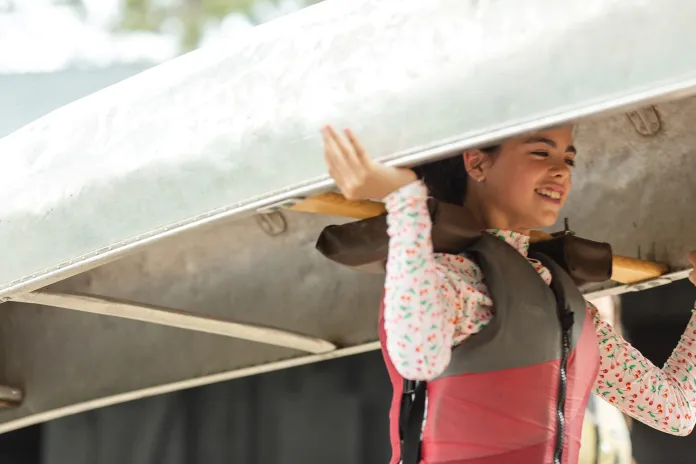
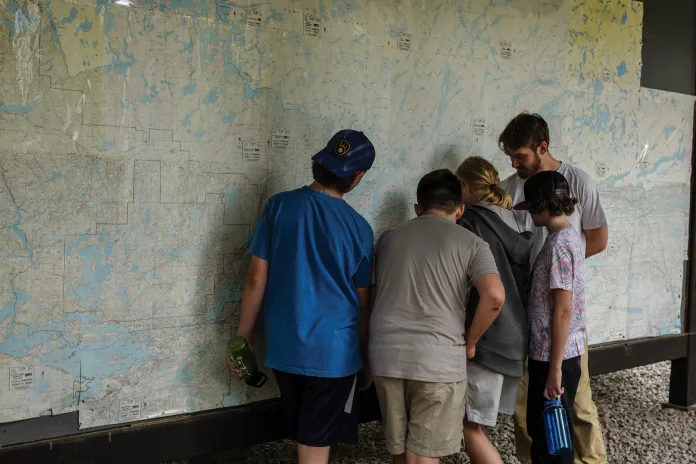
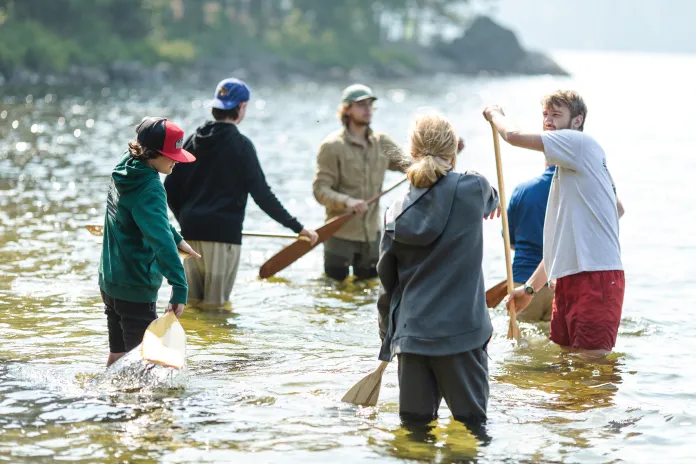
Coda: Smart planning leads to safe returns
Current wilderness program director Brent Saxton described the Big Board as “the best puzzle” he’s worked on, going on to share more about his experience using it:
“During my first summer in the wilderness program director role in 2022, Amy [Hadow] and I used the physical Big Board for the last time. We were already in the process of adopting August’s digital Big Board but wanted to have a physical backup as well, so the picture I sent (above) is the last one ever. We’ve preserved it in the office for the time being and it will forever be summer of 2022 on this board. Moving to the digital Big Board has been great for the admin team and trail staff alike. It helps keep track of time off, eligible drivers, and makes it easier to experiment with different scheduling solutions. Not having to physically move the magnets around when change is needed means less stress for everyone. Additionally, it makes it easier for staff to read and interpret the schedule and gives them a better understanding of how it is determined. So far, most have been thankful that their summer schedule is not as shrouded in mystique and secrecy, though the potential for sudden change remains.”
Returning to story of the unplanned evacuation from the summer of 2012, Hadow ultimately left Widji to rescue the group of campers with another counselor, Sarah “SJ” Johnson, after accounting for every possible variable.
Together, they took the van, a canoe trailer, bikes, and a saw, and headed out to try to find this group. There were a few places they had identified on the map that the group might be able to get to. They tried biking down one road, but it was impassable. They found an alternate route and headed that direction.
Ultimately, they found a spot they thought the group could get to and set up camp. They waited for several hours as the group was paddling against the current, and eventually, Hadow heard them and went to help get them to shore. Campers and staff were safe and back to camp, and Hadow and Johnson’s magnets went back into the mix of the Big Board.